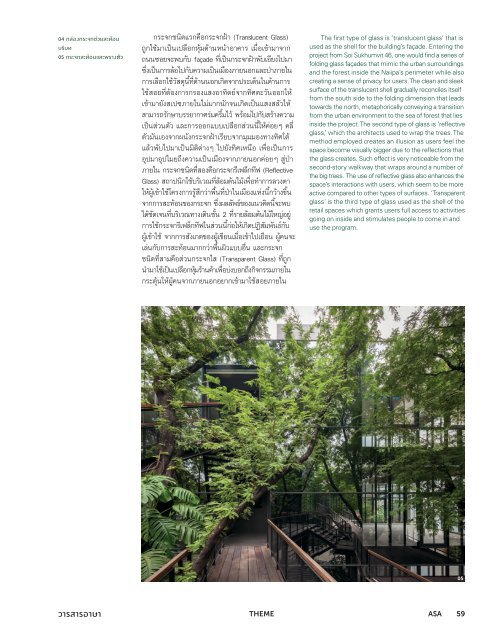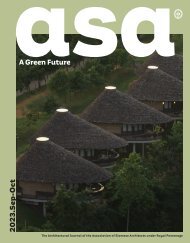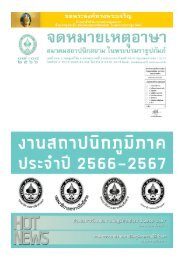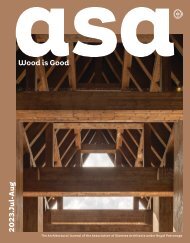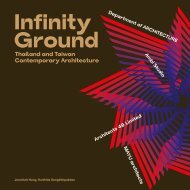ASA JOURNAL 06/59
You also want an ePaper? Increase the reach of your titles
YUMPU automatically turns print PDFs into web optimized ePapers that Google loves.
04 กล่องกระจกช่วยสะท้อน<br />
บริบท<br />
05 กระจกสะท้อนและพรางตัว<br />
กระจกชนิดแรกคือกระจกฝ้า (Translucent Glass)<br />
ถูกใช้มาเป็นเปลือกหุ้มด้านหน้าอาคาร เมื่อเข้ามาจาก<br />
ถนนซอยจะพบกับ façade ที่เป็นกระจกฝ้าพับเอียงไปมา<br />
ซึ่งเป็นการล้อไปกับความเป็นเมืองภายนอกและป่าภายใน<br />
การเลือกใช้วัสดุนี้ที่ด้านนอกเกิดจากประเด็นในด้านการ<br />
ใช้สอยที่ต้องการกรองแสงอาทิตย์จากทิศตะวันออกให้<br />
เข้ามายังสเปซภายในไม่มากนักจนเกิดเป็นแสงสลัวให้<br />
สามารถรักษาบรรยากาศร่มครึ้มไว้ พร้อมไปกับสร้างความ<br />
เป็นส่วนตัว และการออกแบบเปลือกส่วนนี้ให้ค่อยๆ คลี่<br />
ตัวมันเองจากผนังกระจกฝ้าเรียบจากมุมมองทางทิศใต้<br />
แล้วพับไปมาเป็นมิติต่างๆ ไปยังทิศเหนือ เพื่อเป็นการ<br />
อุปมาอุปไมยถึงความเป็นเมืองจากภายนอกค่อยๆ สู่ป่า<br />
ภายใน กระจกชนิดที่สองคือกระจกรีเฟล็กทีฟ (Reflective<br />
Glass) สถาปนิกใช้บริเวณที่ล้อมต้นไม้เพื่อทาการลวงตา<br />
ให้ผู้เข้าใช้โครงการรู้สึกว่าพื้นที่ป่าในเมืองแห่งนี้กว้างขึ้น<br />
จากการสะท้อนของกระจก ซึ่งผลลัพธ์ของแนวคิดนี้จะพบ<br />
ได้ชัดเจนที่บริเวณทางเดินชั้น 2 ที่รายล้อมต้นไม้ใหญ่อยู่<br />
การใช้กระจกรีเฟล็กทีฟในส่วนนี้ก่อให้เกิดปฏิสัมพันธ์กับ<br />
ผู้เข้าใช้ จากการสังเกตของผู้เขียนเมื่อเข้าไปเยือน ผู้คนจะ<br />
เล่นกับการสะท้อนมากกว่าพื้นผิวแบบอื่น และกระจก<br />
ชนิดที่สามคือส่วนกระจกใส (Transparent Glass) ที่ถูก<br />
นามาใช้เป็นเปลือกหุ้มร้านค้าเพื่อบ่งบอกถึงกิจกรรมภายใน<br />
กระตุ้นให้ผู้คนจากภายนอกอยากเข้ามาใช้สอยภายใน<br />
The first type of glass is ‘translucent glass’ that is<br />
used as the shell for the building’s façade. Entering the<br />
project from Soi Sukhumvit 46, one would find a series of<br />
folding glass façades that mimic the urban surroundings<br />
and the forest inside the Naiipa’s perimeter while also<br />
creating a sense of privacy for users. The clean and sleek<br />
surface of the translucent shell gradually reconciles itself<br />
from the south side to the folding dimension that leads<br />
towards the north, metaphorically conveying a transition<br />
from the urban environment to the sea of forest that lies<br />
inside the project. The second type of glass is ‘reflective<br />
glass,‘ which the architects used to wrap the trees. The<br />
method employed creates an illusion as users feel the<br />
space become visually bigger due to the reflections that<br />
the glass creates. Such effect is very noticeable from the<br />
second-story walkway that wraps around a number of<br />
the big trees. The use of reflective glass also enhances the<br />
space’s interactions with users, which seem to be more<br />
active compared to other types of surfaces. ‘Transparent<br />
glass‘ is the third type of glass used as the shell of the<br />
retail spaces which grants users full access to activities<br />
going on inside and stimulates people to come in and<br />
use the program.<br />
05<br />
วารสารอาษา<br />
THEME <strong>ASA</strong> <strong>59</strong>


